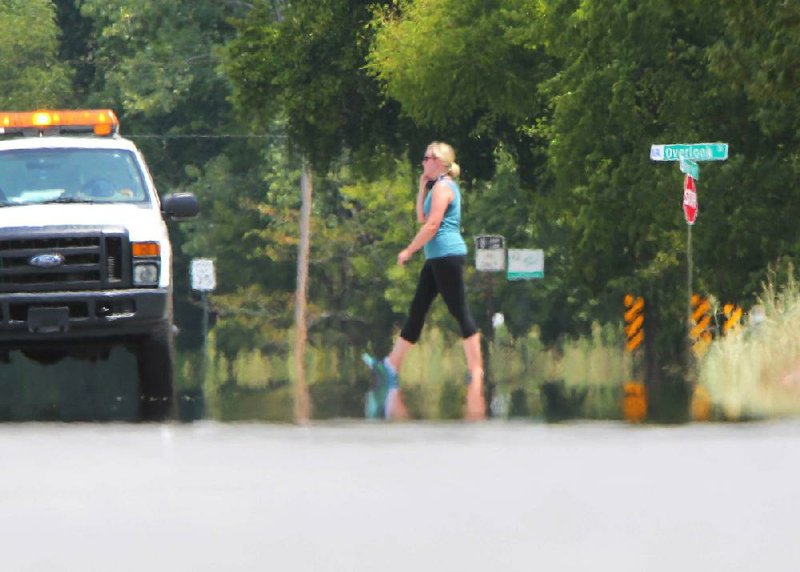LITTLE ROCK — Arkansas roasted in triple digit temperatures Monday as a high-pressure system that withdrew from the state earlier this month returned.
Little Rock’s 111-degree reading was the highest for the state Monday and the capital city’s third-highest mark of all time, National Weather Service meteorologists in North Little Rock said.
Little Rock’s 114 degrees, recorded on Aug. 3, 2011, was the highest temperature ever for the city. Little Rock reached 112 degrees on July 31, 1986, for its second-highest reading.
The highest temperature recorded in Arkansas was 120 degrees set in Ozark on Aug. 10, 1936.
Searcy in White County reached 111 at the Searcy Municipal Airport at 3 p.m., said Don Lytle, who works there.
“It’s like being in the desert without the sand,” he said of the heat. “It’s hot and dry.”
Farther north, a National Weather Service station in Silver Hill in Searcy County recorded 110 degrees.
Jacksonville saw a high Monday of 109 degrees, Stuttgart reached 108 degrees, and Russellville and Mountain Home each hit 107 degrees.
Batesville, North Little Rock, Fort Smith, Siloam Springs, Monticello, Hot Springs and Mena all saw high temperatures of 106 degrees.
Northwest Arkansas also saw the mercury rise above 100. Fayetteville and Highfill both reached 103 degrees, and Springdale saw 102 degrees.
In Fort Smith, the heat knocked out an air-conditioning unit in the weather service’s monitoring station, forcing the service to turn its radar off there.
“It got critical,” said Joe Sellers, a meteorologist with the National Weather Service in Tulsa. “Other things were going to get damaged by the heat if we didn’t shut it down.”
The northeast corner of the state remained the coolest. Jonesboro reached 103, and Walnut Ridge hit 102 degrees, but other cities didn’t top 100 degrees. Blytheville’s temperature climbed to 97 degrees before a late afternoon shower dropped temperatures into the upper 80s.
The North Little Rock Community Center opened as a shelter Monday, but no one had sought refuge by late afternoon. The city implements its heat-relief policy whenever the heat index reaches 105 degrees.
The heat index indicates how hot the air feels by combining the actual temperature with humidity.
While temperatures climbed in the state, the humidity levels dropped, causing concern for Arkansas Forestry Commission firefighters.
The weather service said humidity in central Arkansas dropped to 22 percent by Monday afternoon - an unheard of low level for the summer, said Joe Goudsward, a National Weather Service meteorologist in North Little Rock.
Winds from the southwest also brought warmer conditions and helped fan fires.
Sheila Doughty, a spokesman for the commission, said firefighters were battling an 88-acre blaze near Mount Riante in Garland County. The fire has been burning there since Sunday.
“We’re dropping water on it,” she said. “It’s jumped lines and rebuilt. It’s a rough area to get into.”
She said the current fire conditions are normally seen in August.
“Fire season came early,” she said. “We’re just now getting into it. Everything is so dry. There’s lots of fuel out there.”
Temperatures began increasing over the weekend as a ridge of high pressure that withdrew from over the state earlier this month moved back over western Arkansas. The system forces the jet stream, which helps move cooler temperatures and rain-producing fronts, farther north and around the state, Goudsward said.
He said the system could “wobble” a bit to the west today and temperatures could dip into the low 100s.
“It won’t be as oppressive,” he said. “But once you’re in triple digits, it’s all subjective.
“It’s going to be hot.”
A second “wobble” could occur Saturday, and temperatures could drop below 100 degrees for the first time this week.
Day-care operators were among those concerned about the heat.
Frances Tierney, director of Quality Child Care in Conway, said Monday that the high temperatures this summer have prevented children from playing outdoors as much as usual.
When temperatures are high, she said: “We go out shorter periods in the morning ... and everyone's in and out by 9 or 9:30.” If temperatures are close to 100, she said, “We don’t go out at all.”
The hot weather also has affected some of the center’s field trips. At least once this summer, the center has had to cancel a scheduled visit to a local park. Another time, workers took the youngsters there earlier than usual.
To compensate for the lack of physical activity, the center has tried to offer the children more indoor activities, some involving exercise. “But it doesn't take the place of going outside,” Tierney said.
High school football practices kicked off Monday with a caution from the Arkansas Activities Association about the heat.
Football players began practicing in helmets and shorts for the first time this year and were limited to three hours of workouts Monday and today. They will don pads for the rest of the week.
“It’s brutal out there now,” said Don Brodell, the association’s assistant executive director.
He said the association held seminars earlier this summer about dealing with heat-related illnesses and methods to keep athletes properly hydrated.
The excessive heat has also caused housing-foundation problems, said Brent Stroud, owner of Foundation Pro in Little Rock. He said his business drives steel pilings to help support structures.
“The phone is ringing more these days,” he said. “There’s not enough water in the ground, especially in clay, and it’s contracting.”
The heat has also contributed to the state’s drought conditions. More than 33 percent of Arkansas is considered to be in “exceptional” drought.
Goudsward said the state would need at least 15 inches of rain between August and October to return to normal conditions.
“We need one of those two- to three-day rain events to help,” he said. “And I don’t think that will happen anytime soon.” Information for this article was contributed by Debra Hale-Shelton of the Arkansas Democrat-Gazette.
Front Section, Pages 1 on 07/31/2012
